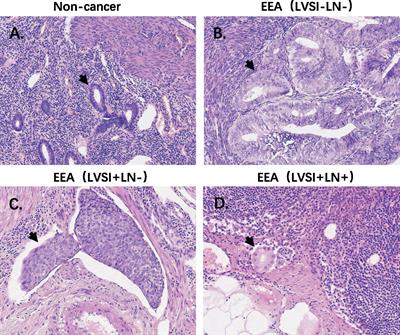|
Anapafseos 5 Agios Nikolaos 72100,Crete,Greece,00302841026182,00306932607174,alsfakia@gmail.com
Blog Archive
- ► 2022 (3010)
- ► 2021 (9899)
-
▼
2020
(4138)
-
▼
December
(1380)
-
▼
Dec 10
(86)
- Sexual Dimorphism in Colon Cancer
- Microbiome Related Cytotoxically Active CD8+ TIL A...
- Cone-Beam-CT Guided Adaptive Radiotherapy for Loca...
- Development and Validation of a Nomogram for Diffe...
- Chinese Herbal Medicine for Reducing Chemotherapy-...
- Role of Specific B-Cell Receptor Antigens in Lymph...
- Reconstruction of Immune Microenvironment and Sign...
- Microsurgical Lymphedema Treatment:
- Morning serum cortisol is superior to salivary cor...
- The role of the superior parietal lobule in lexica...
- Enhanced recovery after breast reconstruction with...
- Brain MRI post-processing with MAP07 in the preope...
- Surgical management of the fourth ventricular tumo...
- FAM46A expression is elevated in glioblastoma and ...
- Delayed transhemispheric propagation of electrogra...
- Early-Onset Autosomal Recessive Spastic Ataxia of ...
- Papillary Tumor of the Pineal Region in Pediatric ...
- Reconstruction of chronic scalp erosion after deep...
- A Study of TAR-200 in Combination With Cetrelimab ...
- Triamcinolone Levels in Cochlear Perilymph, Latera...
- The Effect of Non-resistance Technique for Neck Pa...
- Ramucirumab and Trifluridine/Tipiracil or Paclitax...
- Study of Pharmacokinetic, Safety, Immunogenicity a...
- Acute Myeloid Leukemia: From Biology to Clinical P...
- MR-Guided Radiotherapy for Prostate Cancer
- The Accuracy of Different Modalities of Perforator...
- Analysis of N6-Methyladenosine Methyltransferase R...
- Prevalence of oral mucosal normal variations and l...
- Repurposing Cationic Amphiphilic Drugs and Derivat...
- Comprehensive Molecular Characterizations of Chine...
- A Hematological-Related Prognostic Scoring System ...
- Concurrent Genetic Alterations and Other Biomarker...
- Systematically Characterizing A-to-I RNA Editing N...
- Molecular Alterations in Metastatic Ovarian Cancer...
- Integrative Analysis of Multi-Omics Identified the...
- Identification of Novel MeCP2 Cancer-Associated Ta...
- Cadherins, Selectins, and Integrins in CAM-DR in L...
- Beyond TNBC: Repositioning of Clofazimine Against ...
- Neutrophils as Orchestrators in Tumor Development ...
- Qualitative MR Imaging Features for the Differenti...
- A Nomogram Based on Serum Biomarkers and Clinical ...
- Macrophages in Osteosarcoma Immune Microenvironmen...
- Stereotactic Body Radiation Therapy for Extracrani...
- Types of Mastectomies and Immediate Reconstruction...
- Cepharanthine induces the proliferation of human d...
- The Role of Hippocampal Neurogenesis in ANT-DBS fo...
- Efficacy of antimicrobial photodynamic therapy wit...
- Antimicrobial peptides for the prevention and trea...
- PET detectives: Molecular imaging for phaeochromoc...
- NR5A1 c.991‐1G > C splice‐site variant causes fami...
- Klotho gene G395A and C1818T polymorphisms in acro...
- The use of growth hormone therapy in adults with P...
- Oxytocin in young children with Prader‐Willi syndrome
- Association of urinary free cortisol with bone for...
- SRY‐negative 46,XX testicular/ovotesticular DSD: l...
- Classification and morphology of middle mesial can...
- Peroneal Flap – How to Harvest and Clinical Apprai...
- Inferior Alveolar Nerve Reconstruction in Extensiv...
- Technical Principles and Clinical Workflow of Tran...
- The human melanocyte and melanoblast populations p...
- Efficacy and Safety of Mesenchymal Stem Cell Clust...
- Efficacy and Safety of Pembrolizumab (MK-3475) Plu...
- Pilot Study of a 1-Millimeter Resolution Clinical ...
- Systemic Inflammation Response Index Is a Predicto...
- Retention and survival rate of etanercept in psori...
- The Goldman‐Fox Syndrome: Treating and Preventing ...
- Evaluation of lens clarity in children with atopic...
- Antimicrobial photodynamic therapy in the treatmen...
- Increased risk of depression and impairment in qua...
- Scrotal erythema and geographic tongue subsequent ...
- Dermoscopic characterization of guttate psoriasis,...
- Skin manifestations in SARS‐CoV‐2 infection
- Topical and Systemic Retinoids for the Treatment o...
- Evaluation of Oral Isotretinoin Effects on Hearing...
- Losartan for treatment of epidermolysis bullosa – ...
- investigation of thyroid blood tests and thyroid u...
- Rituximab in Practice: Clinical Evaluation of Pati...
- The Most Common Allergens
- The risk for severe COVID 19 in patients with auto...
- Hypertrichosis and hair repigmentation in patients...
- Adalimumab in the management of hidradenitis suppu...
- Unsuccessful palliative treatment of extraocular s...
- Ectropion surgery might not be a long‐term solutio...
- Can Rituximab Be Used In The Treatment Of Pemphigu...
- The additive efficacy of therapeutic low‐intensity...
- Safety and efficacy profile of oral cyclosporine v...
-
▼
Dec 10
(86)
-
▼
December
(1380)
- ► 2019 (2429)
Αλέξανδρος Γ. Σφακιανάκης
Thursday, December 10, 2020
Reconstruction of Immune Microenvironment and Signaling Pathways in Endometrioid Endometrial Adenocarcinoma During Formation of Lymphovascular Space Involvement and Lymph Node Metastasis
Subscribe to:
Post Comments (Atom)



No comments:
Post a Comment